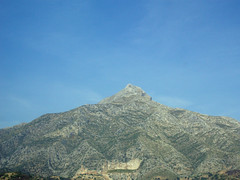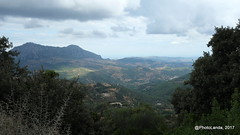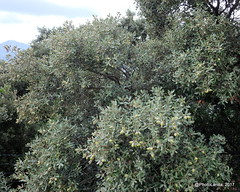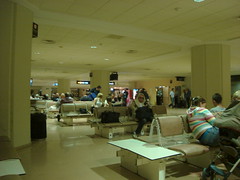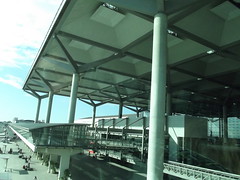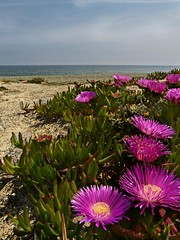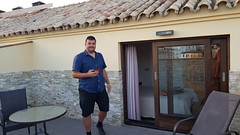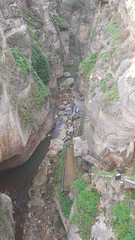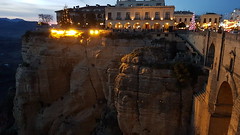Marbella
Marbella (English: /mˈbjə/ , English: /mˈbɛlə/ , Spanish: [maɾˈβeʎa]) is a city and municipality in southern Spain, belonging to the province of Málaga in the autonomous community of Andalusia. It is part of the Costa del Sol and is the headquarters of the Association of Municipalities of the region; it is also the head of the judicial district that bears its name.
Marbella is situated on the Mediterranean Sea, between Málaga and the Strait of Gibraltar, in the foothills of the Sierra Blanca. The municipality covers an area of crossed by highways on the coast, which are its main entrances.
In 2018 the population of the city was 141,463 inhabitants, making it the second most populous municipality in the province of Málaga and the seventh in Andalusia. It is one of the most important tourist cities of the Costa del Sol and throughout most of the year is an international tourist attraction, due mainly to its climate and tourist infrastructure.
The city also has a significant archaeological heritage, several museums and performance spaces, and a cultural calendar with events ranging from reggae concerts to opera performances.
Geography
The Marbella municipality occupies a strip of land that extends along of coastline of the Penibético region, sheltered by the slopes of the coastal mountain range, which includes the Bermeja, Palmitera, Royal, White and Alpujata sub-ranges. Due to the proximity of the mountains to the coast, the city has a large gap between its north and south sides, thus providing views of the sea and mountain vistas from almost every part of the city. The coastline is heavily urbanised; most of the land not built up with golf courses has been developed with small residential areas. Marbella is bordered on the north by the municipalities of Istán and Ojén, on the northwest by Benahavís, on the west by Estepona and on the northeast by Mijas. The Mediterranean Sea lies to the south.
Topography
There are five geomorphological units: the Sierra Blanca, the Sierra Blanca piedmont (foothills), the lower hill country, the plains and the coastal dunes. The Sierra Blanca is most centrally located in the province, looming over the old village. This mountain range has three peaks: La Concha, located further west at above sea level, Juanar Cross, located eastward (within the municipality of Ojen) at above sea level, and the highest, Mount Lastonar, located between the two at . Marbella's topography is characterised by extensive coastal plains formed from eroded mountains. North of the plain, is an area of elevations from , occupied by low hills, with foothills and steeper slopes of the mountains behind. The coast is generally low and has sandy beaches that are more extensive further east, between the fishing port and . Despite the intense urbanisation of the coast, it still retains a natural area of dunes, the Artola Dunes (Dunas de Artola), at the eastern end of town.
Hydrography
The entire region lies within the Andalusian Mediterranean Basin. The rivers are short and have very steep banks, so that flash floods are common. These include the Guadalmina, the Guadaiza, the Verde and the Rio Real, which provide most of the water supply. The irregularity of rainfall has resulted in intermittent rivers that often run dry in summer; most of the many streams that cross the city have been bridged. The La Concepción reservoir supplies the population with drinking water; apart from this there are other reservoirs like El Viejo and El Nuevo (the Old and the New) that irrigated the old agricultural colony of El Ángel, and Las Medranas and Llano de la Leche that watered the plantations of the colony of San Pedro de Alcántara.
Demographics
According to the census of the INE for 2018, Marbella had a population of 141,463 inhabitants, which ranked it as the second-most populous city in the province of Málaga and eighth in Andalusia after surpassing Cádiz in 2008. Unlike other towns in the Costa del Sol, Marbella had a significant population before the population explosion caused by the tourist boom of the 1960s. The census counted about 10,000 people in 1950; population growth since has been as great as that of neighboring towns. Between 1950 and 2001 the population grew by 897%, with the decade of the 1960s having the highest relative increase, at 141%. In 2001, only 26.2% of Marbella's population had been born there, 15.9% were foreign-born, and those born in other towns in Spain made up the difference. During the summer months the population of Marbella increases by 30% with the arrival of tourists and foreigners who have their second homes in the area.
The population is concentrated in two main centres: Marbella and San Pedro Alcántara; the rest is scattered in many developments in the districts of Nueva Andalucia and Las Chapas, located along the coast and on the mountain slopes. According to a study by the Association of Municipalities of the Costa del Sol, based on the production of solid waste in 2003, Marbella had a population of about 246,000 inhabitants, almost twice that of the population census of 2008. From the estimated volume of municipal waste in 2010, the City calculates the population during the summer months at around 400,000 people, while official police sources estimated it at about 500,000, with a peak of up to 700,000 people.
Demonyms
Traditionally the people of Marbella have been called "marbelleros" in the local vernacular and "marbellenses" in more formal registers; these names have appeared in dictionaries and encyclopedias. Since the mid-1950s, however, Marbellan residents have been called "marbellís" or "marbellíes", the only gentilic, or demonym, that appears in the Diccionario de la Lengua Española (Dictionary of the Spanish Language) published by the Royal Spanish Academy.
The use of "marbellí" as a gentilic was popularised by the writer and journalist Víctor de la Serna (1896–1958), who wrote a series of documentary articles on "The Navy of Andalucía"; in his research he had come upon the Historia de Málaga y Su Provincia (History of Málaga and the Province) by Francisco Guillén Robles, who used the plural word "marbellíes" to designate the Muslim inhabitants of Marbella.
History
Prehistory and antiquity
Archaeological excavations have been made in the mountains around Marbella which point to human habitation in Paleolithic and Neolithic times. Some historians believe that the first settlement on the present site of Marbella was founded by the Phoenicians in the 7th century BC, as they are known to have established several colonies on the coast of Málaga province. However, no remains have been found of any significant settlement, although some artefacts of Phoenician and later Carthaginian settlements have been unearthed in different parts of the municipality, as in the fields of Rio Real and Cerro Torrón.
The existence of a Roman population centre in what is now the El Casco Antiguo (Old Town) is suggested by three Ionic capitals embedded in one section of the Murallas del Castillo (Moorish castle walls), the reused materials of a building from earlier times. Recent discoveries in La Calle Escuelas (School Street) and other remains scattered throughout the old town testify to a Roman occupation as well. West of the city, on the grounds of the Hotel Puente Romano, is a small 1st century Roman Bridge over a stream. There are ruins of other Roman settlements along the Verde and Guadalmina rivers: Villa Romana on the Rio Verde (Green River), the Roman baths at Guadalmina, and the ruins of a Roman villa and an early Byzantine basilica at Vega del Mar, built in the 3rd century and surrounded by a paleo-Christian necropolis, later used as a burial ground by the Visigoths. All of these further demonstrate a continued human presence in the area. In Roman times, the city was called Salduba (Salt City).
Middle Ages
During the period of Islamic rule, after the Normans lay waste to the coast of Málaga in the 10th century, the Caliphate of Córdoba fortified the coastline and built a string of several lighthouse towers along it. In the Umayyad fashion they constructed a citadel, the Alcazaba, and a wall to protect the town, which was made up of narrow streets and small buildings with large patios, the most notable buildings being the citadel and the mosque. The village was surrounded by orchards; its most notable crops were figs and mulberry trees for silkworm cultivation. The current name most likely developed from the name the Arabs gave it: Marbal·la (مربلة), which may in turn derive, according to some linguistic investigations, from a previous Iberian place name. The traveller Ibn Battuta characterised it as "a pretty little town in a fertile district." During the time of the first kingdoms of Taifa, Marbil-la was disputed by the Taifas of Algeciras and of Málaga, eventually falling into the orbit of Málaga, which in turn later became part of the Nazarid Kingdom. In 1283 the Marinid sultan Abu Yusuf Yaqub ibn Abd Al-Haqq launched a campaign against the Kingdom of Granada. Peace between the Marinid dynasty and the Nasrid dynasty was achieved with the signing of the Treaty of Marbella on 6 May 1286, by which all the Marinid possessions in Al-Andalus were restored to the Nazarid sultan.
Early modern age
On 11 June 1485, the town passed into the hands of the Crown of Castile without bloodshed. The Catholic Monarchs gave Marbella the title of city and capital of the region and made it a realengo (royal protectorate). The Plaza de los Naranjos was built along the lines of Castilian urban design about this time, as well as some of the historical buildings that surround it. The Fuerte de San Luis de Marbella (Fort of San Luis) was built in 1554 by Charles V. The main door faced north and was protected by a moat with a drawbridge. Today, the ruins of the fort house a museum, and on the grounds are the Iglesia del Santo Cristo de la Vera Cruz (Church of the Holy Christ of the True Cross) and Ermita del Calvario (Calvary Cha…
Looking for places related to Marbella?
Those are other destinations to find places related to Marbella:



